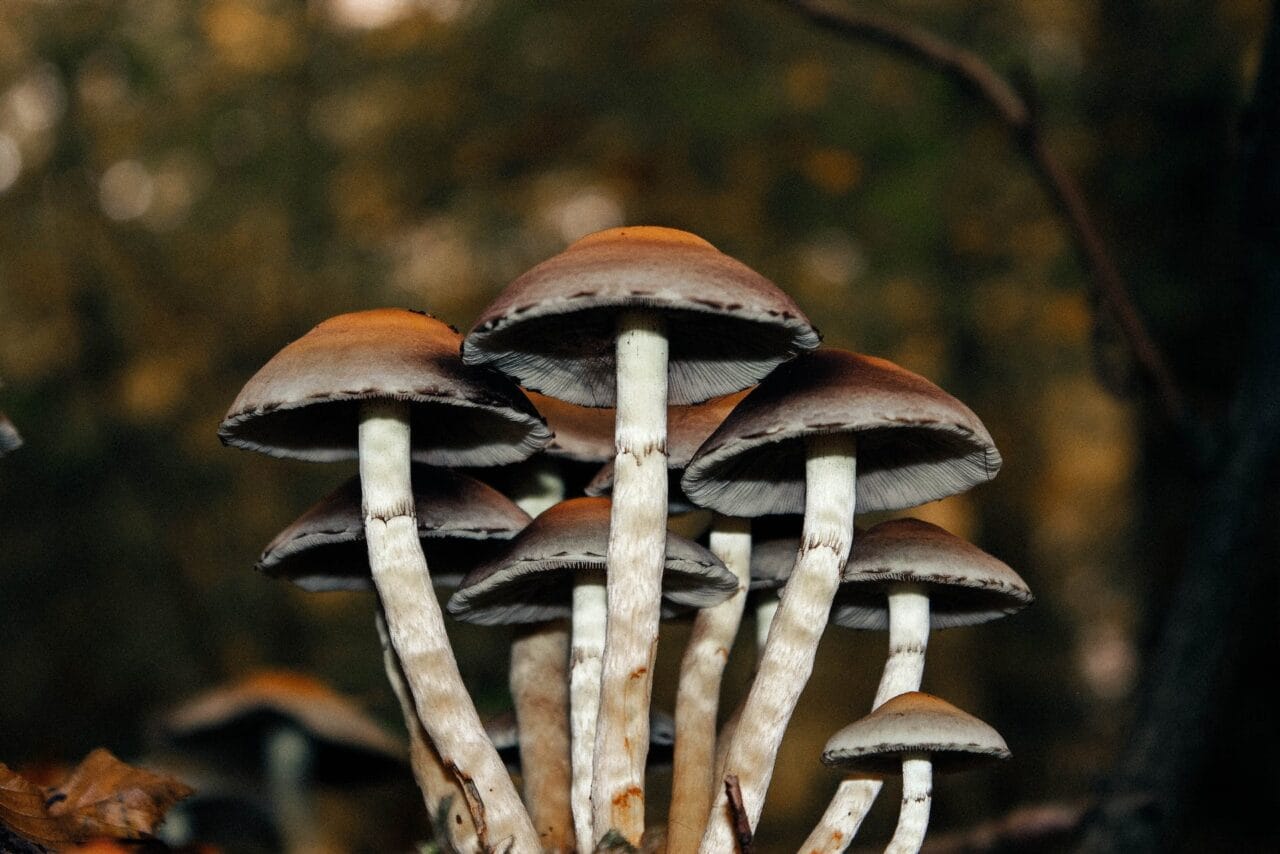Psilocybin, a psychoactive compound discovered in magic mushrooms, is often utilized recreationally to induce euphoria and hallucinations.
Aside from its mind-altering properties, research has also delved into its potential benefits for chronic pain relief.
This article provides a case study that investigates the potential of microdosing mushrooms in managing chronic pain.
Key Highlights:
- Microdosing mushrooms could potentially provide both short-term and sustained pain alleviation.
- When compared to conventional pain medications, psilocybin microdosing typically exhibits fewer side effects when consumed in small quantities.
- Psilocybin interacts with serotonin 2A (5-HT2A) receptors, helping to mitigate pain, among other conditions.

The Study
The research, “Microdosing Psilocybin for Chronic Pain: A Case Series“, was carried out by Dr. Matthew Lyes and his team from the Division of Pain Medicine in the Department of Anesthesiology at the University of California, San Diego. Their study revolved around three patients who self-administered psilocybin in small doses to control their chronic pain symptoms.
Three Patients, One Result – Chronic Pain Relief
Patient # 1
| AGE/ GENDER: | 37 Male |
| PAIN TYPE: | Neuropathic pain displayed below the site of a spinal cord injury. |
| PAIN INTENSITY: | Initially rated at 4 to 5/10, later escalating to 8/10 |
| PSILOCYBIN DOSE: | 250 mg of ground mushroom for less than 6 months |
| OUTCOME: | Discontinued prescribed pain medication, reduction of muscle spasms, and improved bowel movement efficiency. No signs of rebound pain or withdrawal symptoms were observed. |
| The patient noted that while his regular medications only managed to lessen the pain, psilocybin effectively eliminated it, reducing his average pain level from 5 to 0. | |
Patient #2: A Case Study
| AGE/GENDER: | 69-year-old Female |
| NATURE OF PAIN: | Complex Regional Pain Syndrome (CRPS) |
| PAIN INTENSITY: | Typically varies from 5 to 7 on a scale of 10; increases with physical activity and during pain flare-ups |
| PSILOCYBIN DOSAGE: | Daily consumption of 500 mg for 7 to 10 days, followed by rest periods (2 to 3 days) for a year. Dosage increases to 750 mg to 1 gram during pain flare-ups |
| EFFECTIVENESS: | Experiences an 80% reduction in pain for 3-4 hours, which gradually returns to original levels after 12 hours. Complete pain relief (90%-100%) is reported for 6-8 hours, returning to initial levels after 18 hours. |
| The patient suffers from a reduced appetite without any nausea. There is noted instability or disorientation in walking when the dosage is heightened (750 to 1000mg). | |
Patient #3: A Case Study
| AGE/GENDER: | 40-year-old Female |
| NATURE OF PAIN: | Lumbar radiculopathy and neuropathic pain |
| PAIN INTENSITY: | 8 out of 10, increasing to 10 during physical activities |
| PSILOCYBIN DOSAGE: | 1000 mg from a mushroom chocolate bar every two months. |
| EFFECTIVENESS: | Significant pain relief without any psychoactive effects. An increase in flexibility and functionality is seen. Pain gradually comes back to initial levels over a period of 2-4 weeks. Repeated doses improve management of pain. |
| The patient does not experience any significant physical, cognitive, or behavioural side effects. Her emotional state remains largely unchanged. She continues her regular dosage of SSRI for managing depression during the psilocybin treatment phase. | |
Exploring Pain Management with Psilocybin
Persistent somatic and visceral pain signals strengthen specific neural pathways due to peripheral and central sensitization, resulting in chronic physical and emotional pain. Psychedelics like psilocybin activate 5-HT2A receptors, potentially resetting the brain areas related to neuropathic conditions.
A patient reported pain relief lasting for weeks, suggesting that direct stimulation of the 5-HT2A receptors can lead to central regulation of pain perception and
Adaptability of synapses.
Potential Side Effects of Psilocybin Compared to Conventional Pain Relievers
| PSILOCYBIN (Based on Scientific Studies) | TRADITIONAL PAIN RELIEVERS |
| Muscle spasms | Nausea |
| Diminished appetite | Discomfort in the abdomen |
| Confusion | Headaches |
| Unsteady gait | Addiction |
| No mood changes | Drowsiness |
Future Research Opportunities Regarding Psilocybin
The research team has identified several potential areas for further study based on the experiences of three individuals, due to their potential benefits.
- Psilocybin in small doses could provide immediate and possibly enduring relief from neuropathic pain, without causing physical tolerance or dependency.
- Examine the outcomes of various therapeutic approaches used in conjunction with psilocybin. For instance, patient # 3 reported an improved analgesic effect when psilocybin was combined with physical therapy.
- Small doses of psilocybin may offer pain relief even without psychotherapy, as demonstrated in this case study. The investigators propose that incorporating therapeutic guidance could potentially boost or extend the therapeutic effects.
Study Limitations
Despite the encouraging results seen in the patients, it’s crucial to consider the limitations identified in the study.
- The limited sample size might not accurately represent all individuals afflicted with neuropathic pain.
- The study did not include any individuals who did not respond to psilocybin.
- No assessments were carried out before and after treatment to evaluate the effect of psilocybin on mental health conditions like depression and anxiety.
- Most of the data was self-reported by the subjects.
- The presence of the interviewer and potential bias associated with psilocybin could have influenced the participants’ responses.
- The study did not investigate the potential influence of the placebo effect.
- The study did not determine the psilocybin content in each mushroom.
Microdosing Psilocybin Mushrooms
In our study, participants identified as Patient #1 and #2 consumed a microdose of powdered psilocybin obtained from dried mushrooms, whereas Patient #3 combined it with chocolate. There exists a wide range of products specifically developed for psilocybin microdosing, and we’ve gathered a selection of them below.
Dried Psilocybin Mushrooms
While the study didn’t identify the specific strain used, the following strain can be a useful reference point for those new to the practice.
- Golden Teacher: This is one of the most prevalent and frequently encountered magic mushroom strains.
- Amazonian Cubensis: This strain is well-regarded for being user-friendly and potentially offering cognitive benefits.
- Cambodian: Consuming Cambodian cubensis mushrooms for microdosing may improve focus, social awareness, and mood.
Microdose Capsule Products
- Euphoria Psychedelics – Micro Calm Capsules: This unique concoction features Ashwagandha, Reishi, CBD, Valerian root, and Psilocybin Mushrooms, all of which are scientifically validated to alleviate anxiety and stress.
- Ground Sounds – Microdose Capsules – Champion Lover: This intriguing blend offers three dosage levels: 50mg, 100mg, or 250mg of pure psilocybin paired with reishi, cacao, cordyceps, and maca.
- Kind Stranger – Brighten Capsules 250mg: These capsules feature the Golden Teacher strain, known for promoting clear thinking, increased creativity, and enhanced concentration.
Psilocybin for Pain Relief
Even though research into the analgesic properties of mushrooms is still in its infancy, personal anecdotes and small-scale studies are offering promising signs.
These instances underscore the necessity for more in-depth research into the possible advantages of psilocybin, class=”wp-block-list”>
Microdosing has the potential to enhance mood, productivity, creativity, and focus. Its most prominent benefit, however, is its effect on mental health. This was demonstrated in November 2022 when COMPASS Pathways, a mental health company, revealed their phase 2b trial results. The randomized and double-blind study suggested that a single dose of psilocybin significantly reduced depressive symptoms compared to a placebo, with participants receiving a higher dose of 25 milligrams maintaining an antidepressant response at their twelve-week follow-up. Furthermore, a study published in the Psychiatry Research Journal found psilocybin to be more effective than traditional antidepressant therapies.
Starting with a 0.1-gram dose of psilocybin mushrooms on the first day is recommended. If the desired effects aren’t achieved, it’s advisable to gradually increase the dose by 0.05 grams on each subsequent microdosing day until you find your ideal level. For those with a history of psychotropic drug use, a dose increase to 0.5 grams might be necessary to attain the desired effects.
What precautions should be taken before using mushrooms?
What is the suggested frequency for taking microdoses of mushrooms?
Several established protocols suggest structured schedules for microdosing psychedelics. These protocols vary primarily in the number of “off” days they encompass, which are the days you abstain from microdosing.
The most frequently suggested protocols advise incorporating 1-3 rest days between microdoses. This aligns with the body’s natural tolerance mechanisms. The three protocols under consideration in this context are the Fadiman Protocol, the Stamets Stack, and intuitive microdosing.




